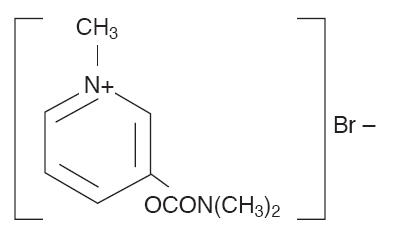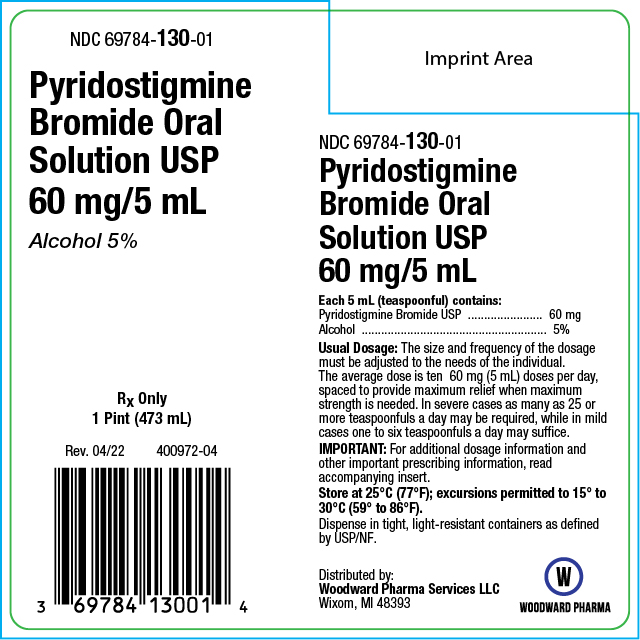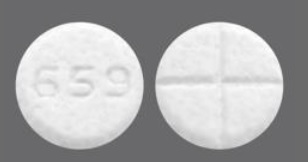Pyridostigmine Bromide Solution: Package Insert / Prescribing Info
Package insert / product label
Dosage form: oral solution
Drug class: Cholinergic muscle stimulants
Medically reviewed by Drugs.com. Last updated on Oct 17, 2024.
On This Page
Pyridostigmine Bromide Solution Description
Pyridostigmine bromide is an orally active cholinesterase inhibitor. Chemically, pyridostigmine bromide is 3-hydroxy-1-methylpyridinium bromide dimethylcarbamate. Its structural formula is:

Pyridostigmine bromide is available as an oral solution containing 60 mg pyridostigmine bromide per teaspoonful in a vehicle containing 5% alcohol, glycerin, lactic acid, sodium benzoate, sorbitol, sucrose, FD&C Red No. 40, FD&C Blue No. 1, flavors and water.
ACTIONS
Pyridostigmine bromide inhibits the destruction of acetylcholine by cholinesterase and thereby permits freer transmission of nerve impulses across the neuromuscular junction. Pyridostigmine is an analog of neostigmine (Prostigmin ®), but differs from it in certain clinically significant respects; for example, pyridostigmine is characterized by a longer duration of action and fewer gastrointestinal side effects.
Indications and Usage for Pyridostigmine Bromide Solution
Pyridostigmine bromide is useful in the treatment of myasthenia gravis.
Contraindications
Pyridostigmine bromide is contraindicated in mechanical intestinal or urinary obstruction, and particular caution should be used in its administration to patients with bronchial asthma. Care should be observed in the use of atropine for counteracting side effects, as discussed below.
Warnings
Although failure of patients to show clinical improvement may reflect underdosage, it can also be indicative of overdosage. As is true of all cholinergic drugs, overdosage of pyridostigmine may result in cholinergic crisis, a state characterized by increasing muscle weakness which, through involvement of the muscles of respiration, may lead to death. Myasthenic crisis due to an increase in the severity of the disease is also accompanied by extreme muscle weakness, and thus may be difficult to distinguish from cholinergic crisis on a symptomatic basis. Such differentiation is extremely important, since increases in doses of pyridostigmine or other drugs of this class in the presence of cholinergic crisis or of a refractory or "insensitive" state could have grave consequences. Osserman and Genkins 1 indicate that the differential diagnosis of the two types of crisis may require the use of Tensilon ®(edrophonium chloride) as well as clinical judgment. The treatment of the two conditions obviously differs radically. Whereas the presence of myasthenic crisis suggests the need for more intensive anticholinesterase therapy, the diagnosis of cholinergic crisis, according to Osserman and Genkins, 1 calls for the prompt withdrawal of all drugs of this type. The immediate use of atropine in cholinergic crisis is also recommended.
Atropine may also be used to abolish or obtund gastrointestinal side effects or other muscarinic reactions; but such use, by masking signs of overdosage, can lead to inadvertent induction of cholinergic crisis.
For detailed information on the management of patients with myasthenia gravis, the physician is referred to one of the excellent reviews such as those by Osserman and Genkins 2, Grob 3 or Schwab. 4,5
Precautions
Pyridostigmine is mainly excreted unchanged by the kidney. 6,7,8 Therefore, lower doses may be required in patients with renal disease, and treatment should be based on titration of drug dosage to effect. 6,7
Adverse Reactions/Side Effects
The side effects of pyridostigmine are most commonly related to overdosage and generally are of two varieties, muscarinic and nicotinic. Among those in the former group are nausea, vomiting, diarrhea, abdominal cramps, increased peristalsis, increased salivation, increased bronchial secretions, miosis and diaphoresis. Nicotinic side effects are comprised chiefly of muscle cramps, fasciculation and weakness. Muscarinic side effects can usually be counteracted by atropine, but for reasons shown in the preceding section the expedient is not without danger. As with any compound containing the bromide radical, a skin rash may be seen in an occasional patient. Such reactions usually subside promptly upon discontinuance of the medication.
To report SUSPECTED ADVERSE REACTIONS, contact FDA at 1-800-FDA-1088 or www.fda.gov/medwatch, or Woodward Pharma Services at 1-888-300-3908.
Related/similar drugs
Pyridostigmine Bromide Solution Dosage and Administration
Pyridostigmine bromide oral solution is available as raspberry-flavored oral solution, containing 60 mg pyridostigmine bromide per teaspoonful (5 mL). This form permits accurate dosage adjustment for children and "brittle" myasthenic patients who require fractions of 60 mg doses. It is more easily swallowed, especially in the morning, by patients with bulbar involvement.
Dosage
The size and frequency of the dosage must be adjusted to the needs of the individual patient.
The average dose is ten 5 mL teaspoonfuls daily, spaced to provide maximum relief when maximum strength is needed. In severe cases as many as 25 teaspoonfuls a day may be required, while in mild cases one to six teaspoonfuls a day may suffice.
How is Pyridostigmine Bromide Solution supplied
Pyridostigmine Bromide Oral Solution, USP, 60 mg pyridostigmine bromide per teaspoonful (5 mL) and 5% alcohol — bottles of 16 fluid ounces (1 pint) (NDC 69784-130-01)
References
- Osserman KE, Genkins G. Studies in myasthenia gravis: Reduction in mortality rate after crisis. JAMA. Jan 1963; 183:97-101.
- Osserman KE, Genkins G. Studies in myasthenia gravis. NY State J Med. June 1961; 61:2076-2085.
- Grob D. Myasthenia gravis. A review of patho-genesis and treatment. Arch Intern Med. Oct 1961; 108:615-638.
- Schwab RS. Management of myasthenia gravis. New Eng J Med. Mar 1963; 268:596-597.
- Schwab RS. Management of myasthenia gravis. New Eng J Med. Mar 1963; 268:717-719.
- Cronnelly R, Stanski DR, Miller RD, Sheiner LB. Pyridostigmine kinetics with and without renal function. Clin Pharmacol Ther. 1980; 28:No. 1, 78-81.
- Miller RD. Pharmacodynamics and pharmacokinetics of anticholinesterase. In: Ruegheimer E, Zindler M, ed. Anaesthesiology. (Hamburg, Germany: Congress; Sep 14-21, 1980; 222-223.) (Int Congr. No. 538), Amsterdam, Netherlands: Excerpta Medica; 1981.
- Breyer-Pfaff U, Maier U, Brinkmann AM, Schumm F. Pyridostigmine kinetics in healthy subjects and patients with myasthenia gravis. Clin Pharmacol Ther. 1985;5:495-501.
| PYRIDOSTIGMINE BROMIDE
pyridostigmine bromide solution |
||||||||||||||||||||||
|
||||||||||||||||||||||
|
||||||||||||||||||||||
|
||||||||||||||||||||||
|
||||||||||||||||||||||
|
||||||||||||||||||||||
|
||||||||||||||||||||||
| Labeler - Woodward Pharma Services LLC (080406260) |
Frequently asked questions
- Can Mestinon be used to treat Postural Tachycardia Syndrome (POTS)?
- How does Mestinon help with myasthenia gravis?
- Can I stop taking Mestinon (pyridostigmine)?
- What's the mechanism for Mestinon (pyridostigmine)?
- Is Mestinon an Immunosuppressant?
More about pyridostigmine
- Check interactions
- Compare alternatives
- Pricing & coupons
- Reviews (59)
- Drug images
- Side effects
- Dosage information
- During pregnancy
- Drug class: cholinergic muscle stimulants
- Breastfeeding
- En español
Patient resources
Professional resources
- Pyridostigmine monograph
- Pyridostigmine (FDA)
- Pyridostigmine Bromide Oral Solution (FDA)
- Pyridostigmine ER tablets (FDA)
- Pyridostigmine Oral Solution (FDA)


